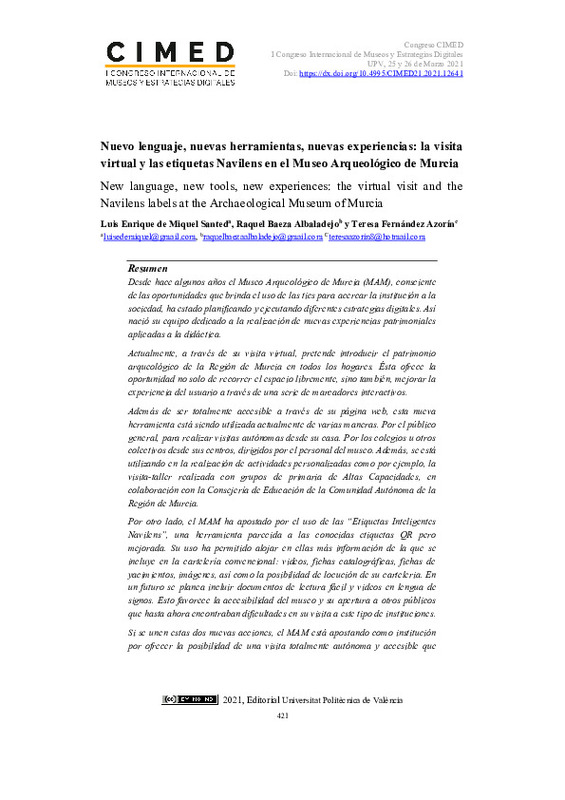|
Resumen:
|
[EN] For some years now, the Archaeological Museum of Murcia (MAM), aware of the
opportunities offered by the use of tics to bring the institution closer to society,
has been planning and executing different digital ...[+]
[EN] For some years now, the Archaeological Museum of Murcia (MAM), aware of the
opportunities offered by the use of tics to bring the institution closer to society,
has been planning and executing different digital strategies. Thus was born his
team dedicated to the realization of new heritage experiences applied to didactics.
Thus was born his team dedicated to the realization of new heritage experiences
applied to didactics.
Currently, through his virtual visit, he intends to introduce the archaeological
heritage of the Region of Murcia in all homes. This offers the opportunity not only
to move around the space freely, but also to improve the user experience through
a series of interactive markers.
In addition to being fully accessible through its website, this new tool is currently
being used in various ways. For the general public, to make autonomous visits
from their home. By schools or other groups from their centers, directed by
museum staff. In addition, it is being used in the realization of personalized
activities such as, for example, the visit-workshop carried out with high-ability
primary groups, in collaboration with the Consejería de Educación de la
Comunidad Autónoma de la Región de Murcia.
On the other hand, MAM has opted for the use of “Etiquetas Inteligentes
Navilens", a tool similar to the well-known QR tags but improved. Their use has
allowed them to house more information than is included in conventional posters:
videos, catalog cards, site files, images, as well as the possibility of announcing
their posters. In the future it is planned to include easy-to-read documents and
videos in sign language. This favors the accessibility of the museum and its
openness to other audiences that until now have encountered difficulties when
visiting this type of institution.
If these two new actions are brought together, the MAM is betting as an institution
to offer the possibility of a totally autonomous and accessible visit that allows the user, if they wish, to carry out practically an “à la carte visit”. This should be the
new language that museum institutions should address. It is not intended, nor is
it intended, to replace the human work of guided tours, but to offer new
complementary possibilities that provide a greater museum experience
Communication in society has changed and museums are at its service, therefore,
the message and the way it is delivered must change.
[-]
[ES] Desde hace algunos años el Museo Arqueológico de Murcia (MAM), consciente de las oportunidades que brinda el uso de las tics para acercar la institución a la sociedad, ha estado planificando y ejecutando diferentes ...[+]
[ES] Desde hace algunos años el Museo Arqueológico de Murcia (MAM), consciente de las oportunidades que brinda el uso de las tics para acercar la institución a la sociedad, ha estado planificando y ejecutando diferentes estrategias digitales. Así nació su equipo dedicado a la realización de nuevas experiencias patrimoniales aplicadas a la didáctica. Actualmente, a través de su visita virtual, pretende introducir el patrimonio arqueológico de la Región de Murcia en todos los hogares. Ésta ofrece la oportunidad no solo de recorrer el espacio libremente, sino también, mejorar la experiencia del usuario a través de una serie de marcadores interactivos. Además de ser totalmente accesible a través de su página web, esta nueva herramienta está siendo utilizada actualmente de varias maneras. Por el público general, para realizar visitas autónomas desde su casa. Por los colegios u otros colectivos desde sus centros, dirigidos por el personal del museo. Además, se está utilizando en la realización de actividades personalizadas como por ejemplo, la visita-taller realizada con grupos de primaria de Altas Capacidades, en colaboración con la Consejería de Educación de la Comunidad Autónoma de la Región de Murcia. Por otro lado, el MAM ha apostado por el uso de las “Etiquetas Inteligentes Navilens”, una herramienta parecida a las conocidas etiquetas QR pero mejorada. Su uso ha permitido alojar en ellas más información de la que se incluye en la cartelería convencional: videos, fichas catalográficas, fichas de yacimientos, imágenes, así como la posibilidad de locución de su carteleria. En un futuro se planea incluir documentos de lectura fácil y videos en lengua de signos. Esto favorece la accesibilidad del museo y su apertura a otros públicos que hasta ahora encontraban dificultades en su visita a este tipo de instituciones. Si se unen estas dos nuevas acciones, el MAM está apostando como institución por ofrecer la posibilidad de una visita totalmente autónoma y accesible que permita al usuario, si lo desea, realizar prácticamente una “visita a la carta”. Este debe ser el nuevo lenguaje al que deben dirigirse las instituciones museísticas. No se pretende, ni se quiere, sustituir el trabajo humano de las visitas guiadas si no ofrecer nuevas posibilidades complementarias que aporten una mayor experiencia museística La comunicación en la sociedad ha cambiado y los museos están al servicio de ésta, por tanto, el mensaje y la manera de emitirlo debe cambiar.
[-]
|








